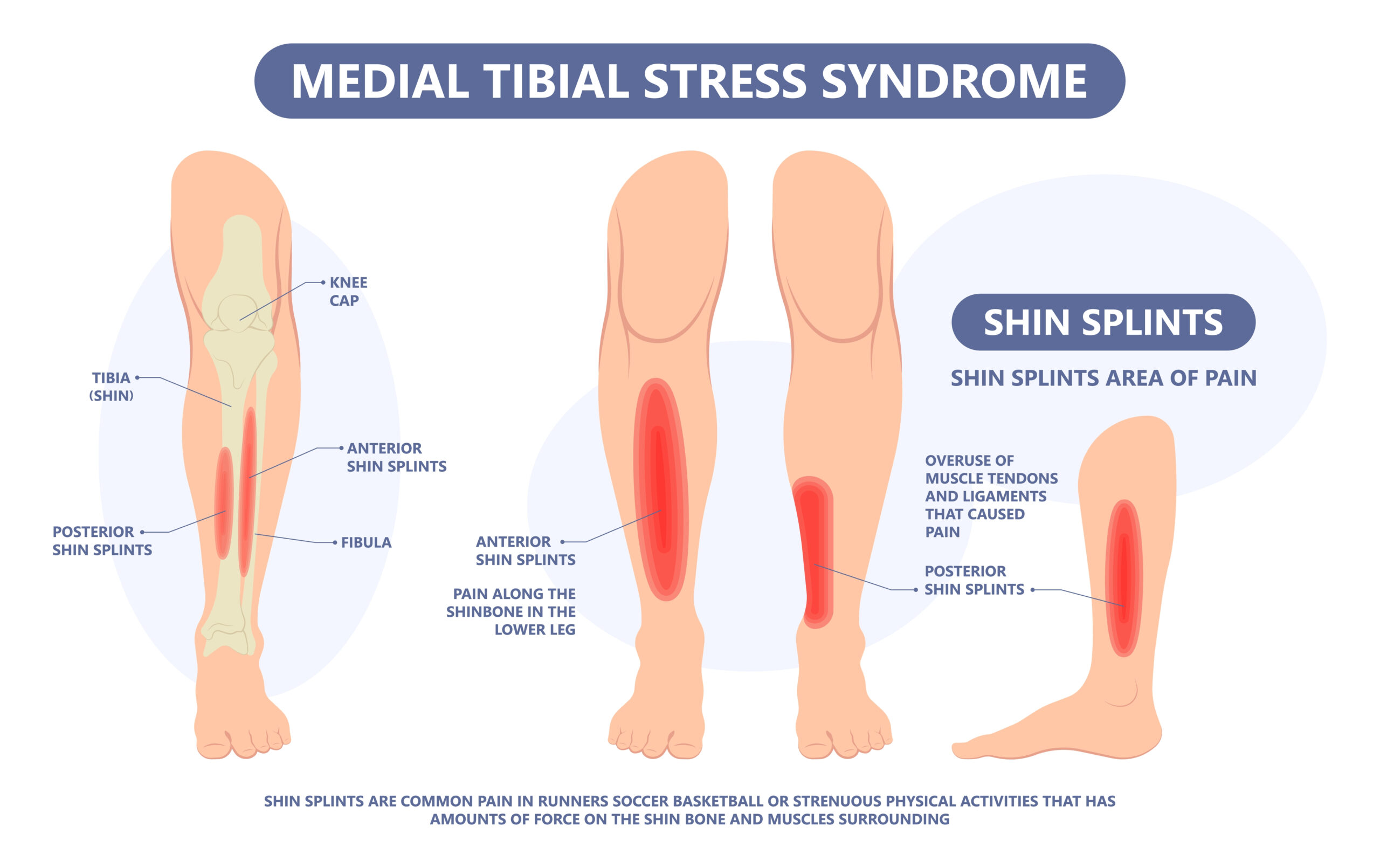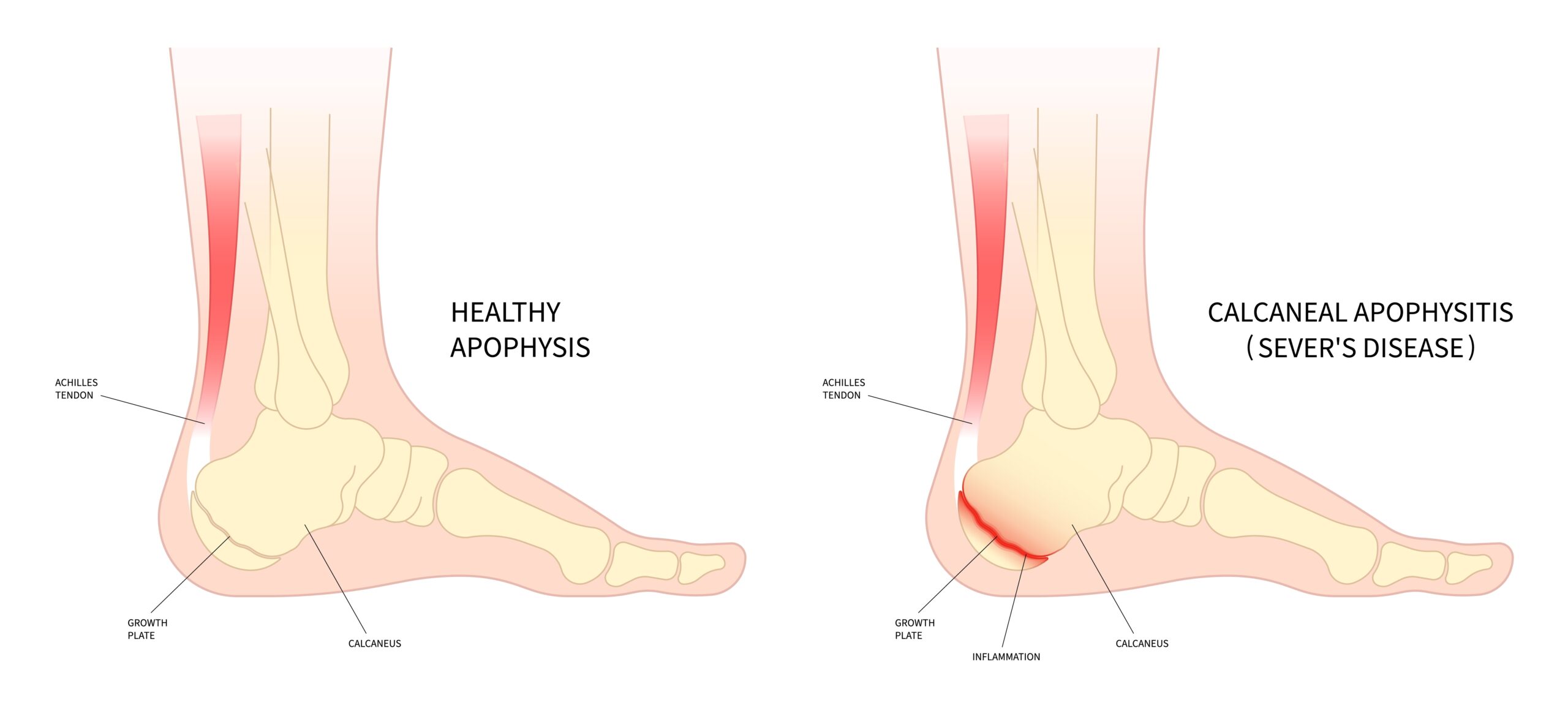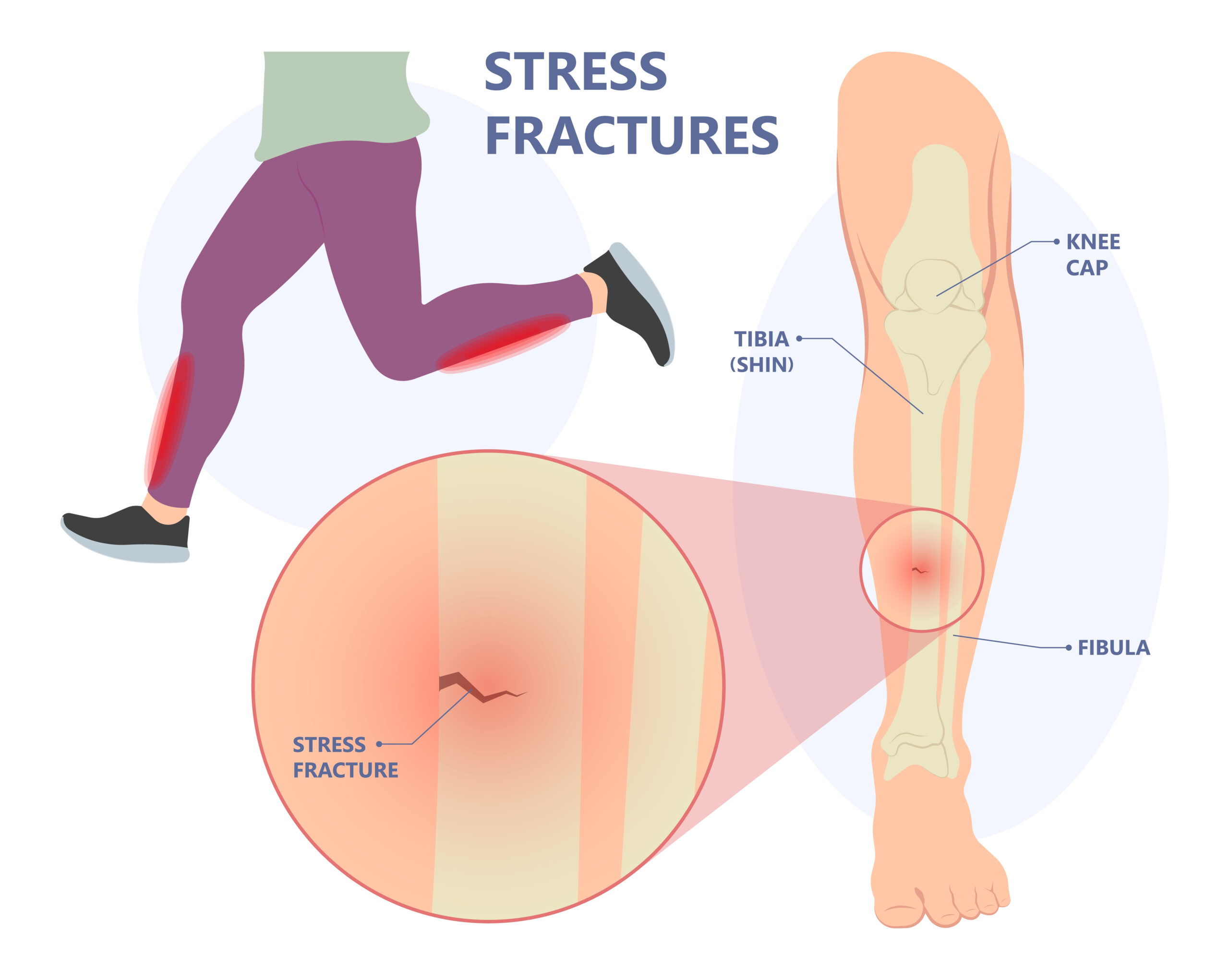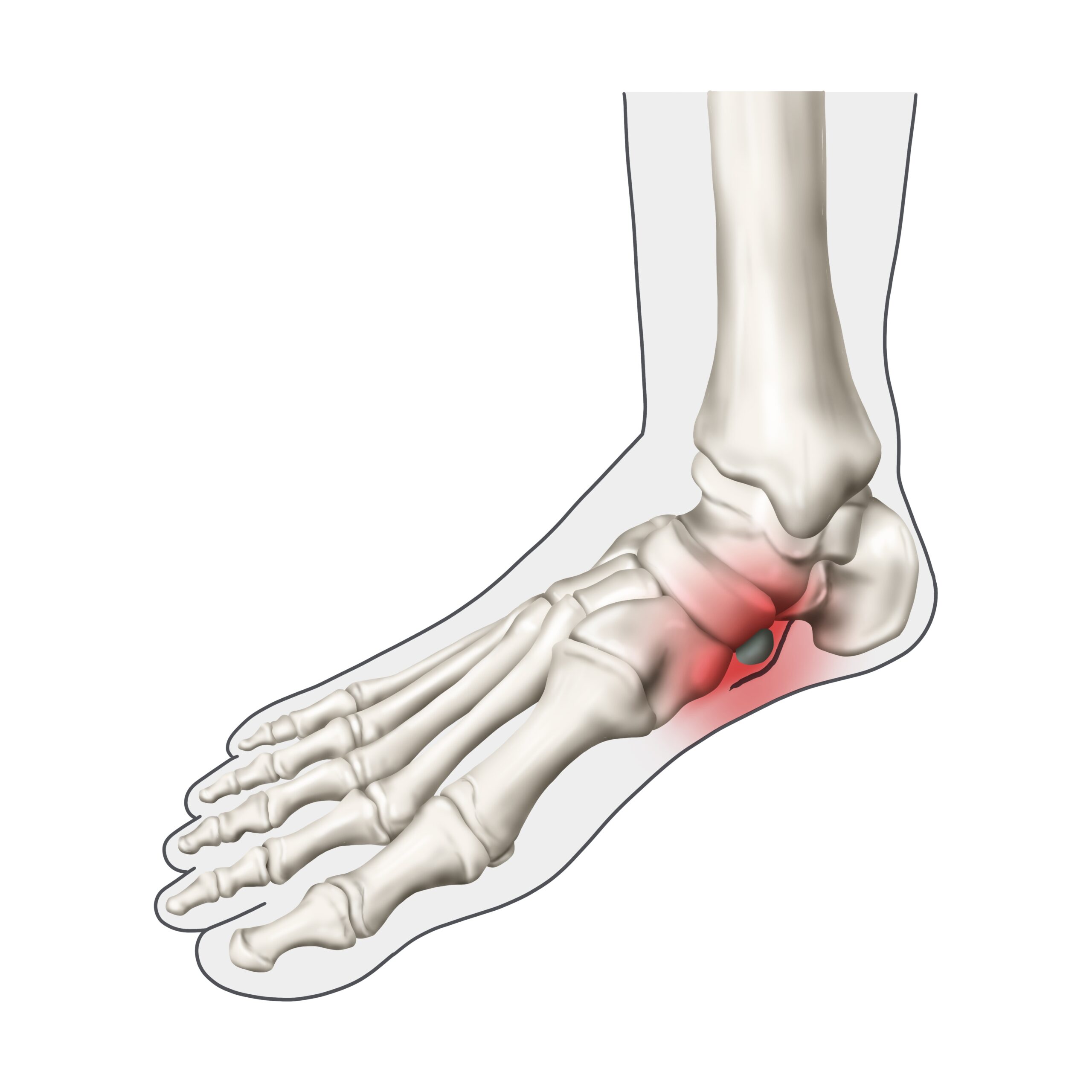1
Lateral (Inversion) Ankle Sprain
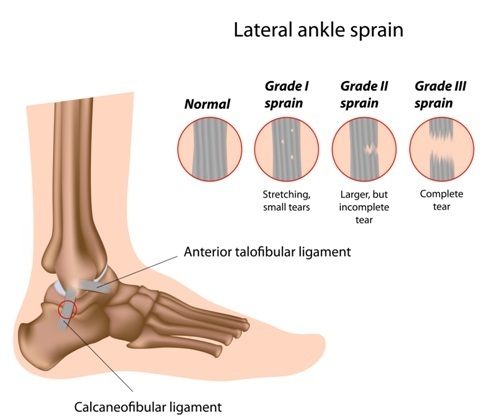
Epidemiology: Can occur at any age and is the most commonly occurring injury in gymnastics.
Mechanism of Injury/Description: Occurs when a gymnast “rolls” their ankle, and happens in three grades:
- Grade 1: Ligaments not disrupted, ecchymosis (bruising), and inflammation (swelling) minimal, and no pain with weight bearing.
- Grade 2: Ligaments stretched but no tear, ecchymosis (bruising), and inflammation (swelling) moderate, and mild pain with weight bearing.
- Grade 3: Ligaments completely torn, ecchymosis (bruising), and inflammation (swelling) severe, and severe pain with weight bearing.
Signs/Symptoms: There will be pain, ecchymosis (bruising), and inflammation (swelling) on the lateral/outside aspect of the foot/ankle, and pain with weight bearing/walking.
Diagnosis: A lateral (inversion) ankle sprain is diagnosed by a physical exam with pain to palpation (touch) of the anterior talofibular ligament (ATFL) and/or calcaneofibular ligament (CFL), a positive anterior drawer test, and a positive talar tilt test. X-rays/Ottawa ankle rules may be used to be sure there are no fractures of the lateral malleolus or 5th metatarsal. Your Medical Provider should consider stress views and be sure to evaluate the mortise. An MRI may also be ordered pending physical exam to evaluate ligamentous status.
Treatment: Depending on the severity your Medical Provider may prescribe a tall walking boot and crutches, physical therapy, RICE, NSAIDs, and sometimes surgery for chronic ankle instability (see section below).
Prevention: To prevent lateral (inversion) ankle sprains, focus on proprioception/single leg balance exercises, landing mechanics, and proper warm up and stretch prior to starting practice.
Gymnastics Medical Provider PEARLS: Be sure you have investigated if the gymnast has a distal fibula physeal fracture, 5th metatarsal fracture, deltoid ligament injury, high ankle sprain, or if the gymnast is now developing chronic ankle instability.
Gymnast, Parent, and Coach PEARLS: Do not ignore ankle sprains and try to self-treat. See a Medical Provider for a diagnosis, treatment, and plan.
2
High Ankle Sprain and Syndesmosis Injury
Epidemiology: Can occur at any age.
Mechanism of Injury/Description: A high ankle sprain usually is associated with a traumatic eversion or external rotation ankle injury.
Signs/Symptoms: The gymnast will experience pain and inflammation (swelling) at the syndesmosis and/or medial/inside ankle with a high ankle sprain.
Diagnosis: The diagnosis for a high ankle sprain is determined by a physical exam with pain and inflammation (swelling) at the syndesmosis and/or medial (inside ankle), a positive squeeze test, and a positive external rotation stress test. An x-ray will show decreased tibiofibular overlap, increased tibiofibular clear space, and increased medial clear space. A CT scan or MRI may be ordered.
Treatment: Non-operative treatment will require no weight bearing to the affected region, a tall walking boot or cast, and physical therapy. Operative treatment will require syndesmosis fixation with a screw or button.
Prevention: Prevention for high ankle sprains include proprioception/single leg balance exercises, working on landing mechanics, and proper warm up and stretch prior to starting practice.
Gymnastics Medical Provider PEARLS: If a high ankle sprain is missed this may results in the gymnast having end stage ankle arthritis. If a high ankle sprain occurs be sure to look for peroneal tendon injuries, osteochondral defects, ankle/foot fractures, deltoid ligament injuries, and loose bodies.
Gymnast, Parent, and Coach PEARLS: Do not ignore eversion/high ankle sprains. See a Medical Provider for diagnosis, treatment, and plan.
3
Medial Tibial Stress Syndrome “Shin Splints”
Epidemiology: Can occur at any age.
Mechanism of Injury/Description: The gymnast will experience pain throughout the tibia (shin bone) where the tibialis anterior muscle attaches. This occurs from repetitive dorsiflexion (flexion at the ankles) and pounding. This can be associated with quick/sudden increases in training volume.
Signs/Symptoms: Signs and symptoms of Medial Tibial Stress Syndrome include pain on the anterior (front) portion of the tibia (usually a section about 1-6” long) with any running or jumping, and possibly even walking. The gymnast usually has flat feet and tight Achilles/posterior leg muscles.
Diagnosis: The diagnosis of Medial Tibial Stress Syndrome is determined by physical exam with pain along the anterior/front portion of the tibia, usually 1-6” area, not “pin point tender”, and pain with jumping/pounding and resisted plantarflexion (pointing your toes). An x-ray is typically performed to rule out a stress fracture or fracture. If symptoms persist, an MRI may be performed/ordered.
Treatment: Treatment for Medial Tibial Stress Syndrome may include rest from pounding/impacting, NSAIDs, a tall walking boot and crutches, and physical therapy.
Prevention: To prevent stress fractures focus on proper increase in training volume and landing mechanics, Achilles flexibility, and having proper levels of vitamin D and Calcium.
Gymnastics Medical Provider PEARLS: If a gymnast presents with a tibial stress fracture or multiple stress fractures be sure to do a female athlete work up as well as check Calcium and Vitamin D levels.
Gymnast, Parent, and Coach PEARLS: If your gymnast develops a stress fracture and you do not believe there was a change to training volume ask your Medical Provider to check Vitamin D and Calcium levels, and optimize sleep (8-10 hours), water intake, and nutrition (well balanced meals and making sure your gymnast is eating enough calories).
4
Calcaneal Apophysitis/Sever’s Disease
Epidemiology: Calcaneal Apophysitis/Sever’s Disease occurs in gymnasts with open growth plates, meaning they are still growing, and have not yet finished going through puberty.
Mechanism of Injury/Description: The result of repetitive pounding and impact on open growth plates causes Calcaneal Apophysitis/Sever’s Disease. The Achilles tendon attaches to the growth plate (apophysis) and from repetitive tugging/pulling this causes inflammation/swelling and pain (similar to Osgood Schlatter’s but in a different location).
Signs/Symptoms: Pain on the calcaneus/heel, pain with jumping/pounding or impact, and a positive squeeze are signs/symptoms of Calcaneal Apophysitis/Sever’s Disease.
Diagnosis: Calcaneal Apophysitis/Sever’s Disease is diagnosed by physical exam with pain to palpate (push) on the medial aspect of the calcaneus/the growth plate, a positive squeeze test, and tight Achilles/gastrocnemius complex. An x-ray can be helpful to rule out other causes of heel pain and an MRI may be ordered if the pain persists, or if there are concerns about other causes of heel pain.
Treatment: RICE, physical therapy (focusing on Achilles stretches), and sometimes a tall walking boot are treatments for Calcaneal Apophysitis/Sever’s Disease.
Prevention: Avoiding repetitive impact/pounding on open growth plates, Achilles (calf) stretching, foot intrinsic strength, and working on proper landing mechanics can prevent Calcaneal Apophysitis/Sever’s Disease.
Gymnastics Medical Provider PEARLS: There are some cases that gymnasts may come in limping from Calcaneal Apophysitis/Sever’s Disease. If this is the case consider a tall walking boot/crutches and aggressive physical therapy would be necessary for the treatment. On x-rays you can occasionally see sclerosis and fragmentation of the calcaneal apophysis but typically the x-ray appears normal.
Gymnast, Parent, and Coach PEARLS: Focus on proper landing mechanics and avoid running on your heels to help prevent this injury. Encourage gymnasts to speak up if he/she is having heel pain.
5
Stress Fracture of the Tibia or Fibula
Epidemiology: A stress fracture can occur at any age.
Mechanism of Injury/Description: A stress fracture occurs from repetitively pounding and impacting on the tibia or fibula, which leads to stress (or microfractures) to the bone. Typically, this occurs when there are NOT periods of rest between pounding, rapid increases in training/pounding.
Signs/Symptoms: Usually pin point pain on the tibia (shin bone) or fibula (bone on the side of your leg) with any pounding or impacting/jumping are signs/symptoms of a stress fracture.
Diagnosis: A stress fracture is diagnosed by physical exam with pain with palpation (touch) on the tibia or fibula, a positive stress test, and pain with a single leg hop. A lateral x-ray will show a “dreaded black line sign,” which indicates a tibia stress fracture. An MRI can also be used to show edema (swelling/inflammation) in the bone.
Treatment: To treat a stress fracture, a gymnast should rest from pounding/impacting, he may be placed in a tall walking boot and crutches, do physical therapy, increase their calcium and vitamin D, and in severe cases, rod placement surgery.
Prevention: Proper increase in training volume and proper landing mechanics will help prevent stress fractures.
Gymnastics Medical Provider PEARLS: An MRI should be obtained if there is a high suspicion of a stress fracture. If the “dreaded black line sign” is seen on x-ray rod placement/surgical intervention may be the treatment. If a gymnast presents with a tibial stress fracture or multiple stress fractures be sure to do a female athlete work up as well as check Calcium and Vitamin D levels.
Gymnast, Parent, and Coach PEARLS: If your gymnast is having shin pain do not ignore it. See a Medical Provider to evaluate and determine the cause of the pain. If your gymnast develops a stress fracture and you do not believe there was a change to training volume ask your Medical Provider about Female Athlete Triad/RED-S, check Vitamin D and Calcium levels, and optimize sleep (8-10 hours), water intake, and nutrition (well balanced meals and making sure your gymnast is eating enough calories).
6
Accessory Navicular Bone
Epidemiology: An accessory navicular bone can occur at any age, but typically occurs in any athlete who goes up on Relevé (dancers, gymnasts, figure skaters). This injury is more common in athletes with flat feet (pes planus), and can also be genetic. It is also more common to be symptomatic in females. An accessory navicular bone is a normal variant in 12% of the population.
Mechanism of Injury/Description: Typically, around age thirteen, the navicular bone which should be ossifying is unable to do so due to constant tugging from the tibialis posterior tendon which attaches on the navicular bone.
Signs/Symptoms: The gymnast will complain of pain on the medial (inside) aspect of the foot on the navicular bone when activating the tibialis posterior tendon or with pounding/impacting.
Diagnosis: The diagnosis of an accessory navicular bone is by physical exam with a prominent bump on the medial (inside) aspect of the navicular bone, and pain to palpation of the navicular bone. An x-ray (specifically an external oblique view) is the best view to see accessory navicular bone.
Treatment: Non-operative treatment for an accessory navicular bone starts with RICE, immobilization, arch supports/change of shoes, and physical therapy. If non-operative/conservative treatment fails then an operative procedure (an excision of the accessory navicular bone) can be performed.
Prevention: Foot intrinsic strength, proprioception and balance, and good landing mechanics can help prevent the formation of an accessory navicular bone.
Gymnastics Medical Provider PEARLS: There is a genetic predisposition for an accessory navicular bone as well as if the gymnast has an accessory navicular bone they are predisposed to also have posterior tibial tendon insufficiency and flat feet.
Gymnast, Parent, and Coach PEARLS: If your gymnast has medial (inside) foot pain see a medical provider for the diagnosis, treatment, and plan.
7
Chronic Ankle Instability
Epidemiology: Can occur at any age, and occurs in gymnasts who have had multiple inversion ankle sprains.
Mechanism of Injury/Description: A gymnast who has had multiple inversion ankle sprains develops chronic ankle instability.
Signs/Symptoms: Signs and symptoms of chronic ankle instability include a history of multiple ankle sprains with each new ankle sprain occurring more easily/frequently than the previous ankle sprains.
Diagnosis: The diagnosis of chronic ankle instability is determined by a physical exam with a positive anterior drawer and talar tilt test (indicating instability/increased movement). An x-ray with stress views is recommended to investigate how much the joint opens up, and an MRI will evaluate the ligamentous status.
Treatment: Treatment for chronic ankle instability depends on the severity of instability and the gymnast may need either non-operative or operative treatment. Non-operative treatment requires rest, a tall walking boot/crutches, and intense physical therapy, as well as taping or bracing with returning to gymnastics. Operative treatment will require surgical tightening of ankle ligaments.
Prevention: Proprioception/single leg balance exercises, working on landing mechanics, and a proper warm up and stretch prior to starting practice will help prevent chronic ankle instability.
Gymnastics Medical Provider PEARLS: Consider ordering stress x-rays to evaluate ligamentous status. Also, be sure to order an MRI to evaluate ligamentous status. Most gymnasts may “brush off” ankle sprains and so be sure you obtain a thorough history of how many ankle sprains have occurred.
Gymnast, Parent, and Coach PEARLS: Do not ignore multiple ankle sprains this leads to chronic ankle instability. Focus on proprioception and balance (on one leg) to decrease the chance of your gymnast developing this injury.
8
Talar OCD
Epidemiology: Talar OCD commonly occurs in gymnasts with open growth plates, meaning they are still growing and have not yet finished going through puberty.
Mechanism of Injury/Description: Talar OCD is believed to be caused by repetitive microtrauma/injury to the bone from pounding and impacting but can also occur from ankle sprains or fractures, and the most common area is in the medial talar dome.
Signs/Symptoms: The gymnast will experience pain in the medial (inside) or anterior (front) aspect of the ankle, inflammation (swelling), have mechanical signs/symptoms meaning catching/locking or feeling like your ankle is stuck, and will usually have swelling/inflammation.
Diagnosis: Talar OCD is diagnosed by a physical exam (tenderness to palpate on the anterior or medial aspect of the ankle, inflammation/swelling, and decreased range of motion) and also with x-ray and MRI (to stage the lesion).
Treatment: Treatment for a Talar OCD depends on the stage of the lesion; your medical provider may start with non-operative treatment (immobilization and non-weight bearing) or operative treatment (arthroscopic, drilling, microfracture, transplant, or another technique).
Prevention: Prevention of Talar OCD lesions include avoiding multiple inversion ankle sprains, proprioception/single leg balance exercises, working on landing mechanics, and proper warm up and stretch prior to starting practice.
Gymnastics Medical Provider PEARLS: When a gymnast sees you for an acute ankle sprain be sure to investigate if you see an OCD lesion on x-ray as this type of lesion does not only come from repetitive overuse but can also be acute from an ankle sprain.
Gymnast, Parent, and Coach PEARLS: Do not ignore ankle pain. See a medical provider for diagnosis, treatment, and plan.
9
Os Trigonum
Epidemiology: An Os Trigonum usually occurs in patients ages eight to thirteen years old, but can occur at any time. This injury is the result of continuously going up on Relevé or extreme plantarflexion. The prevalence ranges from 10-25% of Accessory Ossicles and Sesamoids of the Foot and Ankle per OrthoBullets©.
Mechanism of Injury/Description: When a gymnast continuously goes up on Relevé, the talus posteriorly (in the back) becomes pinched and can break off causing an Os Trigonum.
Signs/Symptoms: Signs/symptoms of an Os Trigonum include pain and pinching on the posterior (back) portion of the ankle.
Diagnosis: The diagnosis is determined by physical exam with tenderness to palpate on the posterior (back) portion of the ankle, pain with provocative plantarflexion, and pain going into Relevé. An x-ray (specifically a lateral radiograph) will show an ossicle in the posterior/back portion of the foot. A lateral view in Relevé may also be considered to look for posterior ankle impingement. Your Medical Provider may also consider an MRI to evaluate for further injury.
Treatment: Non-operative treatment of an Os Trigonum will require rest, physical therapy, and immobilization. Operative treatment for an Os Trigonum will require the removal of the ossicle.
Prevention: To prevent an Os Trigonum avoid repetitive plantarflexion or Relevé, work on proprioception/single leg balance exercises and landing mechanics, and do a proper warm up and stretch prior to starting practice.
Gymnastics Medical Provider PEARLS: An Os Trigonum can potentially lead to Achilels tendon injuries. Consider ordering an MRI not only to view if there is edema in the Os Trigonum but also to evaluate the status of the Achilles.
Gymnast, Parent, and Coach PEARLS: One of the most common ossicles in the foot is an Os Trigonum.
10
Lisfranc Injury
Epidemiology: A Lisfranc injury can occur at any age, but is usually more common in older athletes and males.
Mechanism of Injury/Description: A Lisfranc injury is a tarsometatarsal fracture/dislocation occurring from an axial load (force from above) on a hyper plantarflexed foot/ankle (think big force while landing in Relevé/on your toes).
Signs/Symptoms: The signs/symptoms of a Lisfranc injury are severe mid-foot pain between the first and second metatarsal distally, inability to walk, inflammation (swelling), and ecchymosis (bruising).
Diagnosis: The diagnosis of a Lisfranc injury is by a physical exam with pain to palpation (touch) between the first and second metatarsal distally, inability to walk, inflammation (swelling), ecchymosis (bruising), and pain with forceful plantarflexion (pointing your toe). An x-ray should be ordered (consider a bilateral standing AP) and compare the Lis Franc joints for space/ expanding. A lateral x-ray will show dorsal displacement at the base of the 1st or 2nd metatarsal). A CT scan or MRI may also be ordered to evaluate the injury further.
Treatment: The non-operative treatment for a Lisfranc injury will require a cast for 8 weeks, however, if this is a true fracture dislocation, surgery is needed.
Prevention: Practicing proper landing mechanics can help prevent a Lisfranc injury.
Gymnastics Medical Provider PEARLS: Don’t forget to consider doing a bilateral standing AP to access the Lisfranc joint.
Gymnast, Parent, and Coach PEARLS: If you see an athlete land up on their toes and they have pain between the 1st and 2nd toe send them to see a medical provider.
11
Turf Toe
Epidemiology: Turf toe can occur at any age, and is also commonly seen in soccer players.
Mechanism of Injury/Description: A hyperextension injury to the big toe injuring the plantar capsular-ligamentous complex is how turf toe occurs.
Signs/Symptoms: The gymnast will experience acute pain at the 1st toe, inability to “push off”, and decreased agility.
Diagnosis: Turf toe is determined by a physical exam with inflammation (swelling), pain at the 1st toe, deformity at the MTP joint, decreased motion of the 1st toe, inability to extend the 1st toe, and increased laxity of ligaments. An x-ray is required to rule out fracture. An MRI will show disruption of volar plate on 1st metatarsal.
Treatment: Non-operative treatment for turf toe will require RICE, NSAIDs, taping or stiff boot, and physical therapy. In some cases, operative treatment may be necessary for the treatment of turf toe.
Prevention: Foot intrinsic strength, proprioception and balance, and working on good landing mechanics can help prevent turf toe.
Gymnastics Medical Provider PEARLS: The diagnosis can be made clinically by the inability to hyperextend the hallux MTP joint. Providers can also consider a stiff toed sneaker/shoe for treatment.
Gymnast, Parent, and Coach PEARLS: If your gymnast lands with his/her 1st toe in a hyperextended position seek medical help. Consider working on proper landing mechanics with gymnasts to help prevent his injury.

